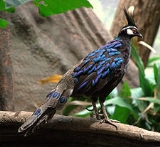
Palawan Peacock Pheasant
Encyclopedia
The Palawan Peacock-Pheasant, Polyplectron napoleonis, is a medium-sized (up to 50 cm long) bird in the family Phasianidae
. It was long known as Polyplectron emphanum (Dickinson 2001).
. It has an erectile crest, a white stripe over the eyes and highly iridescent
metallic green and black plumage. The tail feathers are decorated with large blue-green ocelli
, which may be spread fanlike in courtship displays. The female is smaller than the male. It has a dark brown plumage with a short crest and is whitish on the throat, cheeks and eyebrows.
to the Philippines
, the Palawan Peacock-Pheasant is found in the humid forests of Palawan Island
in the southern part of the Philippine archipelago
. The female usually lays up to two eggs.
(Early? Pliocene
, c.5-4 mya)
offshoot of the genus
Polyplectron (Kimball et al. 2001).
in the IUCN Red List
of Threatened Species. It is listed on Appendix I of CITES.
Phasianidae
The Phasianidae is a family of birds which consists of the pheasants and partridges, including the junglefowl , Old World Quail, francolins, monals and peafowl. The family is a large one, and is occasionally broken up into two subfamilies, the Phasianinae, and the Perdicinae...
. It was long known as Polyplectron emphanum (Dickinson 2001).
Description
The male is the handsomest and most peacock-like member of the genus PolyplectronPolyplectron
The peacock-pheasants are a bird genus, Polyplectron, of the family Phasianidae, consisting of eight species. They are colored inconspicuously, relying on heavily on crypsis to avoid detection. When threatened, peacock-pheasants will alter their shapes utilising specialised plumage that when...
. It has an erectile crest, a white stripe over the eyes and highly iridescent
Iridescence
Iridescence is generally known as the property of certain surfaces which appear to change color as the angle of view or the angle of illumination changes...
metallic green and black plumage. The tail feathers are decorated with large blue-green ocelli
Ocellus
A simple eye refers to a type of eye design or optical arrangement that contains a single lens which detect light. A "simple eye" is so-called in distinction from a multi-lensed "compound eye", and is not necessarily at all simple in the usual sense of the word...
, which may be spread fanlike in courtship displays. The female is smaller than the male. It has a dark brown plumage with a short crest and is whitish on the throat, cheeks and eyebrows.
Distribution and habitat
EndemicEndemism in birds
An endemic bird area is a region of the world that contains two or more restricted-range species, while a "secondary area" contains one or more restricted-range species. Both terms were devised by Birdlife International....
to the Philippines
Philippines
The Philippines , officially known as the Republic of the Philippines , is a country in Southeast Asia in the western Pacific Ocean. To its north across the Luzon Strait lies Taiwan. West across the South China Sea sits Vietnam...
, the Palawan Peacock-Pheasant is found in the humid forests of Palawan Island
Palawan Island
Palawan Island is the largest island of the Palawan Province, Philippines. The northern coast of the island is along the South China Sea, while the southern coast forms part of the northern limit of the Sulu Sea. This island is very undeveloped and traditional...
in the southern part of the Philippine archipelago
Archipelago
An archipelago , sometimes called an island group, is a chain or cluster of islands. The word archipelago is derived from the Greek ἄρχι- – arkhi- and πέλαγος – pélagos through the Italian arcipelago...
. The female usually lays up to two eggs.
Taxonomy
The Palawan Peacock-Pheasant, with its unique male plumage and distant range, represents a basalBasal (phylogenetics)
In phylogenetics, a basal clade is the earliest clade to branch in a larger clade; it appears at the base of a cladogram.A basal group forms an outgroup to the rest of the clade, such as in the following example:...
(Early? Pliocene
Pliocene
The Pliocene Epoch is the period in the geologic timescale that extends from 5.332 million to 2.588 million years before present. It is the second and youngest epoch of the Neogene Period in the Cenozoic Era. The Pliocene follows the Miocene Epoch and is followed by the Pleistocene Epoch...
, c.5-4 mya)
offshoot of the genus
Genus
In biology, a genus is a low-level taxonomic rank used in the biological classification of living and fossil organisms, which is an example of definition by genus and differentia...
Polyplectron (Kimball et al. 2001).
Status and conservation
Due to ongoing habitat loss, small population size and limited range as well as hunting and capture for trade, the Palawan Peacock-Pheasant is classified as VulnerableVulnerable species
On 30 January 2010, the IUCN Red List of Threatened Species identified 9694 Vulnerable species, subspecies and varieties, stocks and sub-populations.-References:...
in the IUCN Red List
IUCN Red List
The IUCN Red List of Threatened Species , founded in 1963, is the world's most comprehensive inventory of the global conservation status of biological species. The International Union for Conservation of Nature is the world's main authority on the conservation status of species...
of Threatened Species. It is listed on Appendix I of CITES.

